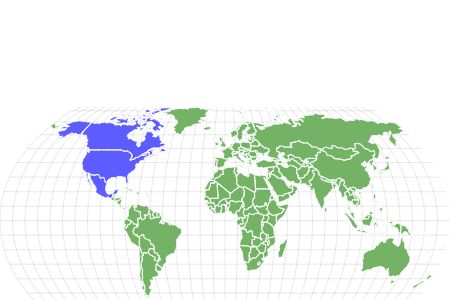Bullsnake
Pituophis catenifer sayi
Considered “The farmer’s friend” because it eats mice and other vermin.
Advertisement
Bullsnake Scientific Classification
- Kingdom
- Animalia
- Phylum
- Chordata
- Class
- Reptilia
- Order
- Squamata
- Family
- Colubridae
- Genus
- Pituophis
- Scientific Name
- Pituophis catenifer sayi
Read our Complete Guide to Classification of Animals.
Bullsnake Conservation Status
Bullsnake Facts
- Prey
- Small mammals, birds, bird’s eggs, frogs, lizards
- Name Of Young
- Hatchlings, snakelets
- Group Behavior
- Solitary except during mating season
- Communal Dens
- Fun Fact
- Considered “The farmer’s friend” because it eats mice and other vermin.
- Litter Size
- Two to 24
- Lifestyle
- Diurnal
- Crepuscular
- Favorite Food
- Small mammals like rats and mice
- Common Name
- Bullsnake
View all of the Bullsnake images!
A Bullsnake is considered “The farmer’s friend.”
This big snake is one of the largest found in North America, especially in the United States and Canada. Though it can be a bit fractious if it feels cornered, it is welcome on farms because it eats mice, rats, and other vermin. Though it doesn’t eat rattlesnakes as often as it’s rumored to do so, the bullsnake does take them once in a great while, too.
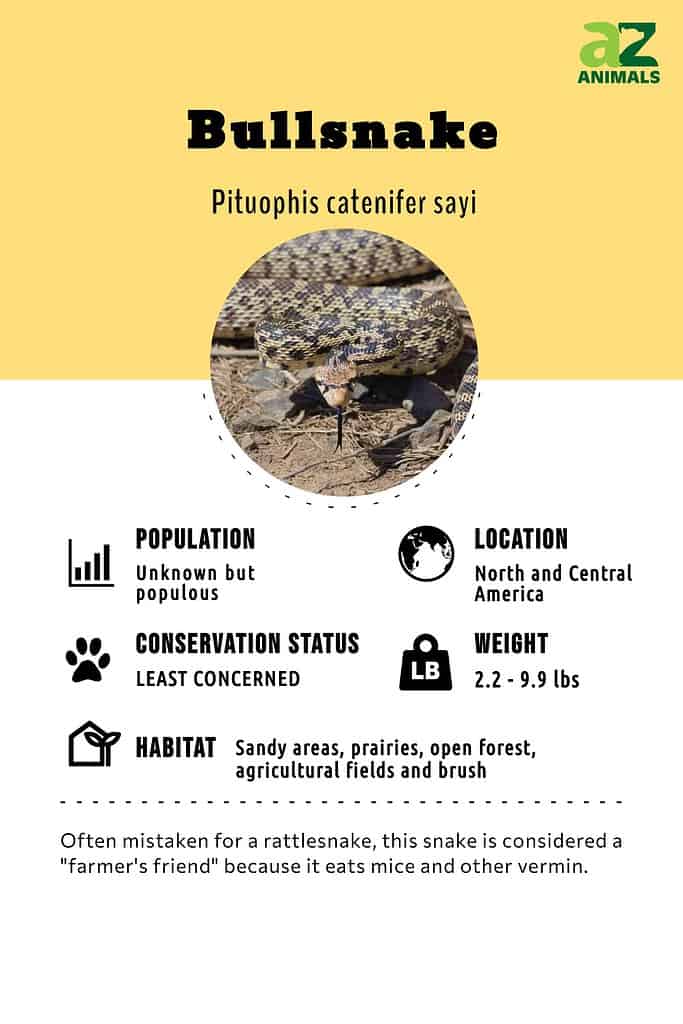
Four Amazing Bullsnake Facts!
Here are four amazing facts about the bullsnake.
- Males are larger than females, which is unusual for snakes.
- The bullsnake is a subspecies of the gopher snake.
- It gets its name because it makes a sound like a bull snorting.
- It spends most of its day in a burrow and has a shield on its nose to help it dig.
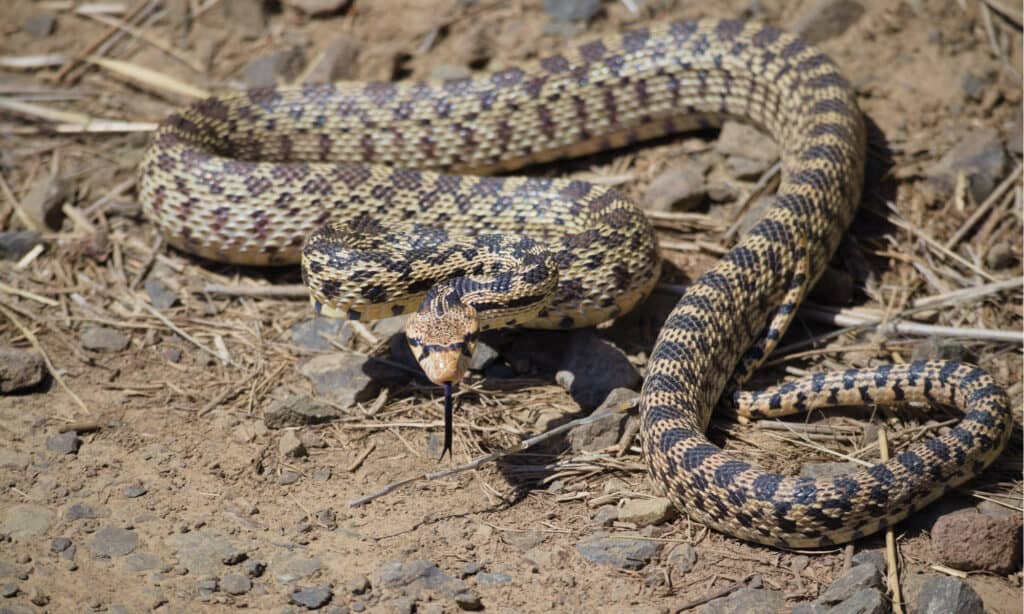
Bullsnakes can be found all across North America and into Mexico.
©Christopher Joe Brown/Shutterstock.com
Where To Find the Bullsnake
Bullsnakes are found all over North America, from Canada to Mexico. Indeed, in Mexico, it is called the cincuate. It shelters in abandoned gopher burrows in habitats such as grasslands, farms, and open areas.
Scientific Name
The bullsnake’s scientific name is Pituophis catenifer sayi. Pituophis comes from the Greek for “pine” which is pitys and the Greek word for “serpent,” which is ophis. Catenifer is Latin and means “chain-bearing.” This refers to the pattern on the snake’s body. Sayi comes from Thomas Say, who was an American naturalist.

Evolution
Fossil records show that snakes first appeared during the Cretaceous period — although often retained their hind limbs. The earliest true snake fossils come from the marine simoliophiids, the oldest being hassiophis terasanctus, dated between 112 and 94 million years ago.
Scientists believe that snakes descended from lizards. Pythons and boas, the most primitive snakes, have vestigial hind limbs and some have remnants of a pelvic girdle, appearing as horny projections.
Many modern snakes originated during the Paleocene, alongside the radiation of mammals that occurred after the extinction of non-avian dinosaurs. The expansion of grasslands in North America led to a major radiation of snakes. During the Miocene, the number of snake species increased with the first vipers and elapids and the diversification of Colubridae.
Different Types of Bullsnake
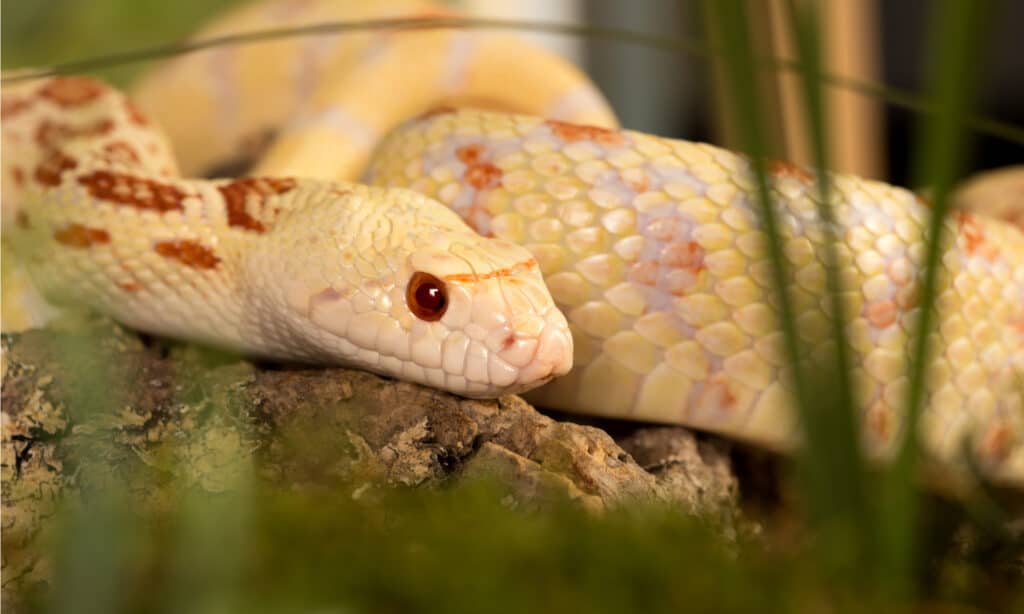
Albino bullsnakes have paler colorations than regular bullsnakes.
©Anneka/Shutterstock.com
The bullsnake is a subspecies of the gopher snake and has become a popular pet. Breeders have developed several color morphs including ghost, white-sided, leucistic, Axanthic, red, hypo, and patternless. There are also albino and snow bullsnakes. Albino snakes have paler colorations than regular bullsnakes, while snow bullsnakes are almost completely white. If any patterns show, they are very faint.
Population & Conservation Status
Scientists don’t know the exact population of these snakes. However, as a subspecies of P. catenifer, the bullsnake’s population is stable and its conservation status is the least concern.
How To Identify Bullsnake: Appearance and Description
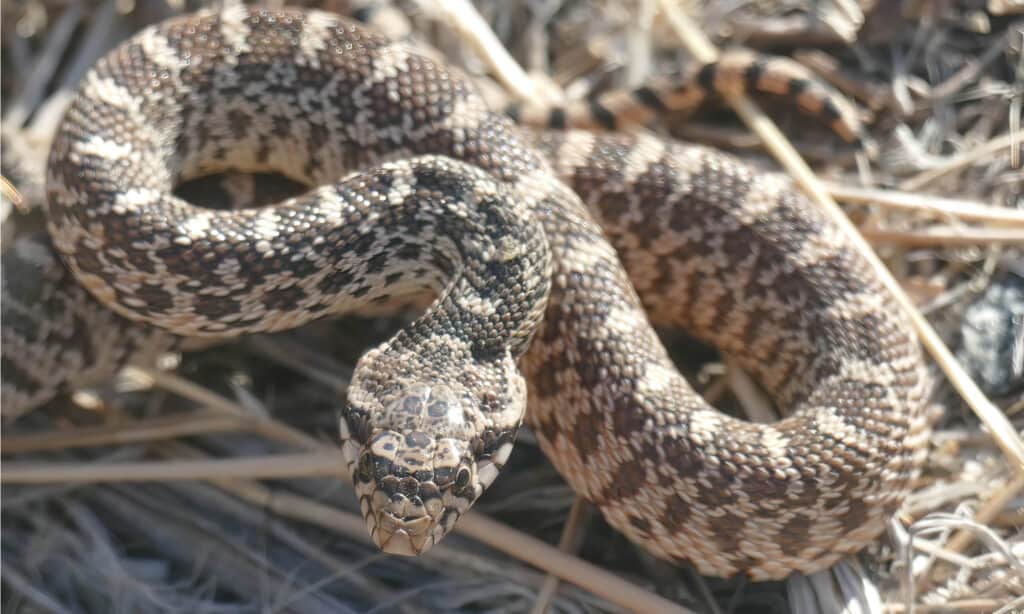
The Bullsnake is similar to the Western Rattlesnake in appearance with black, brown, reddish, or white dorsal blotches on yellow, cream-colored, or beige background.
©steve estvanik/Shutterstock.com
A grown bullsnake is large in size, with a length of as much as 8 feet and a robust body that’s unusual for a member of the usually sleek colubrid family. It usually weighs between 2.2 and 3.3 pounds, though individuals have been found that weigh close to 10 pounds.
Another thing that’s unusual about this nonvenomous snake is that males tend to grow larger than females. A wild bullsnake has black, brown, reddish, or white dorsal blotches on a yellow, cream-colored, or beige ground. The snake usually has spots on its sides, though the sides of some morphs are white. This color pattern makes it resemble a rattlesnake. Baby snakes are gray until their first molt.
The snake doesn’t exactly hibernate but goes dormant during the fall or when food is scarce. It’ll go dormant in a burrow in October and emerge in April — the start of the mating season in some of its range. During its dormancy, it is not unusual to find this otherwise solitary snake with garter snakes, milk snakes, other bullsnakes, or even timber rattlesnakes.

When threatened, the Bullsnake rears up in an S-shape, hisses, and vibrates its tail to mimic the venomous rattlesnake.
©Markparker1983/Shutterstock.com
How Dangerous Are Bullsnakes?
Bullsnakes are only dangerous to prey — they aren’t venomous, but their bite can be painful. Some individuals are docile and can be handled, but others will defend themselves with a threatening posture followed by a bite. When faced with a large potential predator that it can’t quickly escape from, the snake rears up in an S-shape, hisses, and vibrates its tail to mimic the venomous rattlesnake. It may lunge and bite even as it tries to slide away.
Behavior and Humans

Bullsnakes are active during the day and tend to rest at night in old gopher burrows.
©iStock.com/92968526
Outside of the mating season, these snakes are solitary and spend most of their time resting in old gopher burrows. They prefer open habitats with loose soil. Bullsnakes are active during the day and kill their prey through constriction. They usually take rodents such as mice and rats, but they’re good climbers and have been seen raiding nests for eggs and baby birds.
The snakes’ breeding season begins in March or April, and the female lays her eggs from April to June, depending on where she lives. She usually lays about a dozen eggs in a sheltered area and then leaves them. The baby snakes hatch sometime in August. The lifespan of the snake ranges from 12 to as many as 30 years. Longer life is seen in snakes that are given good care in captivity.
View all 284 animals that start with BBullsnake FAQs (Frequently Asked Questions)
Are bullsnakes venomous?
Bullsnakes aren’t venomous.
How do bullsnakes hunt?
Bullsnakes, like other snakes, use their forked tongue to pick up the scent of potential prey. The molecules are then transferred to the Jacobson’s organ, which lets the snake know which type of prey they’re tracking. It also uses its eyes to find prey. When the prey is in striking range, the snake grabs it with its back-curved teeth and wraps its coils around it to constrict it. Constriction doesn’t suffocate the prey but cuts off its blood flow. The snake then swallows the prey whole. Its jaw can come unhinged to let it swallow prey that’s larger than its head.
Where do bullsnakes live?
Bullsnakes live in North America from Canada to Mexico. They’re found in open habitats such as fields, farms, and prairies, especially if the soil is sandy and burrows are easy to dig.
What do bullsnakes eat?
Bullsnakes eat moles, rabbits, and rodents including gophers and ground squirrels. They’ll also eat birds, especially those that nest on the ground, but they’ll climb a tree or a pole to get to a nest or the inside of a nest box. Juvenile bullsnakes eat small lizards, frogs, and baby mice.
Are Bullsnakes aggressive?
Bullsnakes are not terribly aggressive but have been known to rise up in a threat posture if they feel trapped. This can be impressive with a snake the size of a grown bullsnake.
Is a Bullsnake a good pet?
A bullsnake can be a good pet, but they are challenging to keep because they can grow to a quite large size. While some snakes are docile, others can be temperamental.
Do Bullsnakes kill rattlesnakes?
Bullsnakes have been known to kill and eat rattlesnakes, but this is unusual.
Can Bullsnakes kill dogs?
A very large bullsnake can possibly kill and eat a small puppy, but they don’t kill grown dogs. Even if a dog is bitten the bite is not venomous. Still, it is important to have the wound seen to.
How long are bullsnakes?
A bullsnake can grow from 4 to as long as 8 feet, though the usual length is 4 to 6 feet.
What's the longest bull snake on record?
The largest bullsnake on record measured 8.5 feet, with the largest individuals weighing a maximum of about 10 pounds.
Where do bullsnakes live?
The range of bullsnakes stretches from Canada into Mexico across the plains of the midwest. Bullsnakes can be found on the eastern side of Colorado, but don’t live past the Rocky Mountains.
What are the differences between a copperhead and a bullsnake?
The major differences between copperheads and bullsnakes are their sizes and defense mechanisms. Copperheads are much smaller and shorter than bullsnakes, which are known as one of the longest snakes in North America. Bullsnakes are nonvenomous, but copperheads are known for their hemotoxic venom.
Thank you for reading! Have some feedback for us? Contact the AZ Animals editorial team.
Sources
- Kidadl / Accessed March 1, 2022
- Wikipedia / Accessed March 1, 2022
- ITIS / Accessed March 1, 2022
- The Pithuophis Page / Accessed March 1, 2022
- IUCN Redlist / Accessed March 1, 2022
- Britannica / Accessed March 1, 2022
- Weebly / Accessed March 1, 2022

